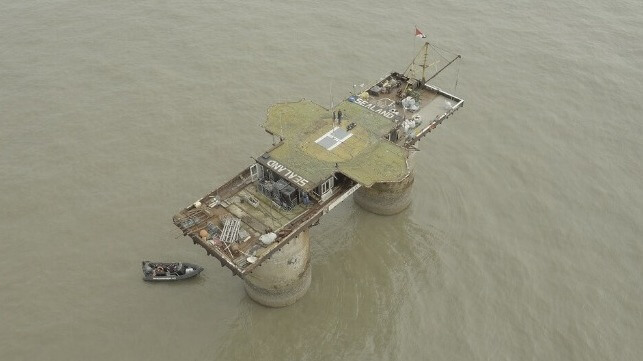Outlaw Ocean Podcast: How the High Seas Became a Metaphor for Freedom

The lawlessness of the oceans provides space to absurd and remarkable stories of renegades and mavericks of all sorts seeking to escape national sovereignty.
Sealand is a perfect example. A “micronation” on an eerie metal platform a few miles off the coast of England into the North Sea, Sealand was an abandoned British anti-aircraft platform. On Christmas Eve of 1966, Paddy Roy Bates, a retired British army major, drove a small boat, used a grappling hook and rope, clambered onto the abandoned platform, declared it conquered and deemed it a gift for his wife, Joan.
Later, Roy announced the establishment of the new nation of Sealand. The motto of the country over which he reigned was E Mare, Libertas, or “From the sea, freedom.” Constituted as a principality, Sealand had its own passport, coat of arms, and flag—red and black, with a white diagonal stripe. Its currency was the Sealand dollar, bearing Joan’s image.
It was not a luxury palace. Built in the early 1940s as one of five forts that defended the Thames, the place was little more than a wide deck about the size of two tennis courts set atop two hollow, concrete towers, 60 feet above the ocean.
The improbable creation story of the world’s tiniest maritime nation was a thumb in the eye of international law. Though no country formally recognizes Sealand, its sovereignty has been hard to deny. The reason goes back to the first principles of sovereignty: A country’s ability to enforce its laws extends only as far as its borders. Roy appeared to be operating legally or at least opportunistically within a legal void.
You can't find two organizations and two people that are more different than Sealand and Women on Waves or Roy Bates and Rebecca Gomperts. But The Outlaw Ocean Project, a non-profit journalism organization based in Washington D.C, followed their stories to show what they have in common: taking advantage of the freedom of the seas to do what they want.
These two stories are told in detail in the fourth episode of The Outlaw Ocean podcast, from CBC Podcasts and the L.A. Times. Listen to it here:
Rebecca Gomperts is a Dutch doctor and founder of Women on Waves, a group that provides access to medical abortions, which entail administering pills to induce miscarriage, for women who live in countries where abortion is restricted or criminalized. Globally, more than twenty million women annually have “unsafe” abortions, and at least forty-seven thousand of them die each year as a result, according to the World Health Organization.
A provision in maritime law treats a ship in international waters like a floating embassy, in effect a detached chunk of the land whose flag it flies. That means the laws that apply on board are only those from the country where the ship is registered. Where a country’s federal law may forbid abortions, the jurisdiction of that law only reaches the limits of national waters or, twelve miles from shore. At the thirteen-mile mark, where international waters begin, abortion is legal on Gomperts’ ship because it flies the flag of Austria, where abortion is permitted.
In Mexico, where The Outlaw Ocean Project accompanied Gomperts on several of her missions, the first trip out to sea was taken before the local government knew about the ship. The big obstacle was the weather. The boat ran aground twice and was nearly beached by the huge waves when leaving the port.
On board were two young women, both in their 20s, both Mexican, who seemed pretty frightened but resolute, and who had come to have abortions. It took about six hours to get from shore to the 12-mile line that divides national and international waters and that's where Gomperts, who's a gynecologist, administered a sonogram to see how far along the young women's pregnancies were. Both were several weeks in, and Gomperts held a counseling session to inform the women of factors to consider. Whether this was the right decision and what they might expect in terms of the after effects of taking the pills.
The second trip out was after Women on Waves had held a press conference. The government reacted strongly and tried every tactic to stop the ship from taking women out to international waters. The government first claimed that the crew did not have proper maritime and visa papers. It closed the port ostensibly due to weather. They threatened Gomperts with arrest for lacking permission to bring women out and back from international waters. None of these tactics withstood their review of a Mexican judge and Gomperts' lawyers, so the boat sailed out a second time with another woman needing an abortion.
Ian Urbina is the director of The Outlaw Ocean Project, a non-profit journalism organization based in Washington DC that focuses on environmental and human rights concerns at sea globally.
The opinions expressed herein are the author's and not necessarily those of The Maritime Executive.

